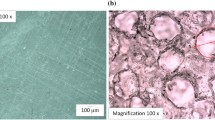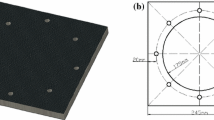Abstract
Silicone foams are used as cushions for impact protection. They are soft and will recover from very large deformation with little damage. Understanding their compression behaviors in high performance environments and providing necessary calibration and validation data for constitutive models are highly important. Characterizing these soft materials, however, is quite challenging. In this study, the foam deformation is carefully studied. With a new compression experimental setup, the force and displacement fields at the foam-platen interface are examined in detail. These additional data will be used to compute the compressive stress-stain behavior of the soft material. The experimental method and foams compression results are presented.
Access provided by Autonomous University of Puebla. Download conference paper PDF
Similar content being viewed by others
Keywords
27.1 Introduction
In an ideal compression test, the specimen is allowed to slide with little friction at the specimen-platen interfaces and to deform uniformly. Unfortunately, for soft materials, part of the side surface of a specimen is often suspected to roll over and becomes in contact with the platen during compression. In such case, a uniform uniaxial state of stress or strain is not achieved. With non-uniform stress and strain distributions of the specimen, the results may be questionable when using surface or volume strain measurement to determine the material’s stress-strain behavior. Lubricants are commonly applied to reduce the friction and improve the uniformity of deformation and pressure, but the effect of lubricants has not been investigated. This paper addresses the deformation and pressure distribution at the interface during a compression test.
27.2 Material and Specimen
Sheets of silicone foam of 50 % and 0 % porosity, shown in Fig. 27.1, were the materials used this investigation; the measured densities were about 0.577 and 1.153 g/cc (36 and 72 pcf), and the thickness of the sheets were approximately 7.061 and 1.930 mm (0.278 in. and 0.076 in.), respectively. Here, if the porosity is not mentioned, the term silicone foam denotes the 50 % porosity material and solid silicone refers to the 0 % porosity material.
Silicone foam is a flexible and open-cell type of foam. Figure 27.2a shows a scanning electron microscope image of the foam, the averaged cell size is about 550 μm (0.022 in.). Compressive specimens used in this investigation were punched out from the sheet. A typical specimen is shown in Fig. 27.2b. The edge of the flat surface was colored so the initial boundary between the flat and cylindrical surfaces could be identified during experiment.
27.3 Experimental Setup
A new compression setup on MTS Bionic System was developed, Fig. 27.3a; a close-up of the testing area is shown in Fig. 27.3b. Between the top platen and the specimen is a thin layer of pressure sensor. It has an array of 44 × 44 sensing elements, which measures the pressure distribution over an area of 27.94 × 27.94 mm (1.1 × 1.1 in.) with a pressure range of 3.45 MPa (500 psi). The area of each sensing element is 0.403 mm2 (0.000625 in.2). The pressure sensor also estimates the contact area. Beneath the specimen is the bottom platen, which is a thick glass sits on a specially designed fixture. The rectangular shape fixture is hollow inside with two openings, one at the top and one at the side wall. By inserting a mirror at 45° angle, it allows the front viewing of the foam-glass interface through the glass platen. A digital camera was utilized to record the interface during compression.
27.4 Experiment
The compression tests were done under quasi-static loading at a rate of 0.0254 mm/s (0.001 in./s) to a very large strain, ΔL/L o was greater than 60 %. The force and displacement were acquired at 10 Hz by the MTS system. Digital videos of the deformation and the pressure distribution at the bottom and top foam-platen interfaces, respectively, were both recorded at 0.5 Hz. All three systems, MTS, video, and pressure scan systems were synchronized. Two sizes of silicone foam, 19.05 and 12.7 mm (0.75 and 0.5 in.) in diameter, and three interface conditions, dry, grease and oil, were considered in this investigation. In this paper only the result of one test, Specimen 03, is discussed in detail; the others are briefly described.
Specimen 03, which had the initial dimension of 19.05 mm (0.75 in.) diameter and 7.06 mm (0.278 in.) height, was compressed under the dry contact condition, i.e. no lubricant was used. Figure 27.4a shows a typical displacement time history of the test, which has a constant speed of loading and unloading; it also includes the history of the corresponding force. The top platen was not in contact with the specimen initially. The force-displacement curve is depicted in Fig. 27.4b. The data indicates the loading begins at the displacement z = 0.457 mm (0.018 in.) or time t = 25 s. The specimen experienced a loading-unloading cycle and returned very close to its original shape at the end of the cycle. It recovered completely eventually.
A series of images taken by the optical digital camera was quantitatively analyzed to examine the deformation of the foam specimen at the bottom platen interface. Two parameters were of interest, which were the diameter of the specimen-platen contact surface, d contact , and the diameter of the deformed bottom surface of the specimen, d bottom face . The measurements were made at each recorded image. Since the boundary of the bottom surface was highlighted with dark color, it could be tracked easily for measuring d bottom face . Focusing on the loading portion of the experiment, Fig. 27.5 displays a few selective images of the interface, at time t = 6, 40, 60, 180 and 210 s. Table 27.1 listed the corresponding values of displacement, load, and the diameters of interest. Initially, i.e. t < 25 s before the loading started, the diameter of the total contact d contact was the same as that of the bottom face d bottom face . As the loading increased, both diameters grew bigger; d contact increased at a rate faster than d bottom face . Take t = 180 s for example, Δd contact = 2.591 mm (0.102 in.) and Δd bottom face = 0.457 mm (0.018 in.).
Clearly, the bottom face did not enlarge much, the increase of the contact area was mostly due to the cylindrical side wall rolled over and got in contact with the platen; only a small portion was from the expending of the bottom surface of the specimen. From the measured diameters and the displacement, the contact area, specimen bottom face area, and the volume of the sample can be calculated for the whole loading cycle, which is shown in Fig. 27.6. The data show that the area of specimen bottom face changes gradually, but speeds up at the end of the loading; it behaves similarly for unloading, changes gradually at the beginning, but speeds up at the end of the unloading. The rate of volume change, on the other hand, gradually decreases as the loading increases. The vertical red line indicates the time that the displacement reaches the maximum. At that time, the axial deformation ΔL max /L o ≈ 62.4 %, the radial deformation (Δd contact ) max /d o ≈ 21.9 %, and the volume deformation ΔV max /V o ≈ 43.0 %. Further loading will cause the force to increase sharply and may exceed the capacity of the pressure sensor. To obtain the data for larger deformation, higher capacity pressure sensor needs to be used.
Figure 27.7 shows selected pressure distributions of the foam-platen interface, which correspond to the same compression states as those show in Fig. 27.6. Three charts are included for each discrete time: the legend (right), raw 2D pressure plot (bottom left), and 90° side view of the 3D contours plot (top left). The pressure scale is optimized for each compression state. The 2D plot shows that the raw pressure data is scattered widely from element to element. It is due to that the size of the pressure sensing element, 0.635 mm × 0.635 mm (0.025″ × 0.025″), and the foam void size, approximately 0.508 mm (0.020 in.) diameter, are about the same. Each sensing elements could have a very different degrees of contact with silicone or void. More data processing is needed to obtain homogenized results. Nonetheless, several qualitative behaviors can be observed. Since the sample is axisymmetric, the 90° side view plot illustrates the pressure distribution across the diameter. The pressure distribution appears to be somewhat uniform when t ≤ 100 s; however, it is evident that the pressure is higher toward the center when t ≥ 180 s. Also, there is a ring of relative high pressure close to the edge. Comparing this result to the optical images of Fig. 27.6, it seems the ring corresponding to the specimen bottom face boundary. More analysis is needed to confirm this result.
Compression tests of silicone foam under different friction conditions were also performed. A thin layer of vacuum grease was applied at top and bottom faces of Specimen 04, and a light lubricant household oil was applied for Specimen 08. Their load-displacement curves are shown in Fig. 27.8. In the figure, the displacements are adjusted so that force and displacement both start to increase from zero at the same time. Specimen 08 was tested for two compression cycles, 08 was the first cycle and 08a was the second cycle. These load-displacement curves are all different. Using different lubricants varies the friction at the interface and results in differences in load-displacement curves. It is not clear why the second cycle of Specimen 08 behaves slight differently from the first cycle, which is not seen in the other cases. It is possible that the oil infiltrates the open cell foam and modifies the behavior. Observing the foam-platen interface, dry surface has the most amount of side surface rolling over and oil lubricated surface is the least.
27.5 Conclusion
A new setup has designed to study the compression behavior of soft materials to very large deformation. Compression tests of silicone foam were performed using various lubricants to change the friction at specimen-platen interface. Depending on the friction, the side surface of the specimen has a different degree of roll over to contact the platen. In general, less roll over is observed for a lower friction interface. The pressure (or stress) distribution at the interface is determined by an array of pressure sensor elements. The pressure is not uniform, typically higher at the center. It is hard to achieve an ideal compression condition for material characterization. The experimental results presented in this paper provide quantitative boundary conditions at the interface, which can be used in numerical analysis to obtain the stress-strain relation of the silicone foam.
Acknowledgements
Sandia National Laboratories is a multi-program laboratory managed and operated by Sandia Corporation, a wholly owned subsidiary of Lockheed Martin Corporation, for the U.S. Department of Energy’s National Nuclear Security Administration under contract DE-AC04-94AL85000.
Author information
Authors and Affiliations
Corresponding author
Editor information
Editors and Affiliations
Rights and permissions
Copyright information
© 2016 The Society for Experimental Mechanics, Inc.
About this paper
Cite this paper
Lu, WY. (2016). Compression of Silicone Foams. In: Ralph, C., Silberstein, M., Thakre, P., Singh, R. (eds) Mechanics of Composite and Multi-functional Materials, Volume 7. Conference Proceedings of the Society for Experimental Mechanics Series. Springer, Cham. https://doi.org/10.1007/978-3-319-21762-8_27
Download citation
DOI: https://doi.org/10.1007/978-3-319-21762-8_27
Publisher Name: Springer, Cham
Print ISBN: 978-3-319-21761-1
Online ISBN: 978-3-319-21762-8
eBook Packages: EngineeringEngineering (R0)












